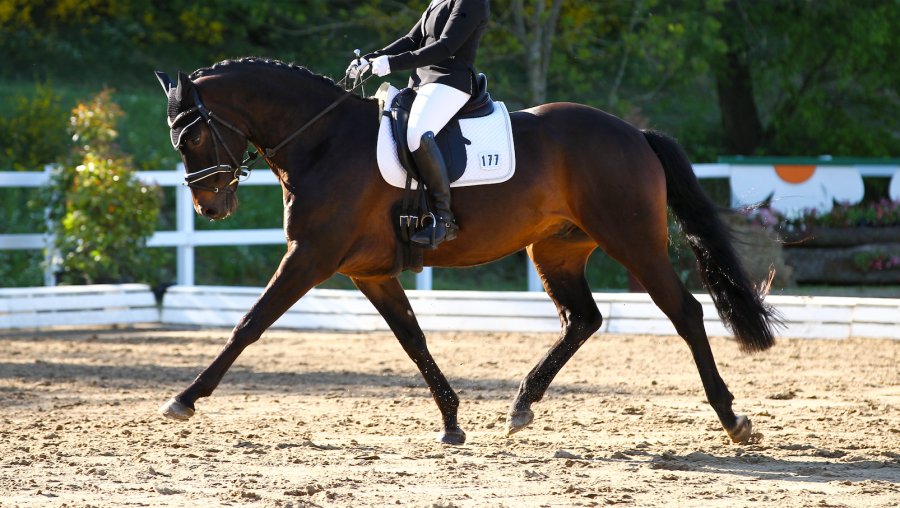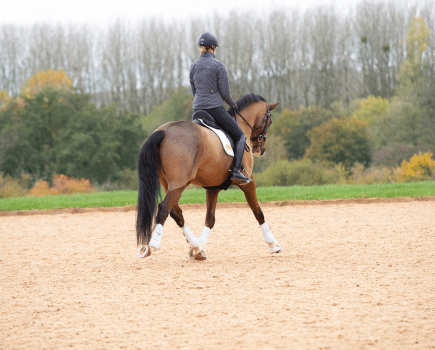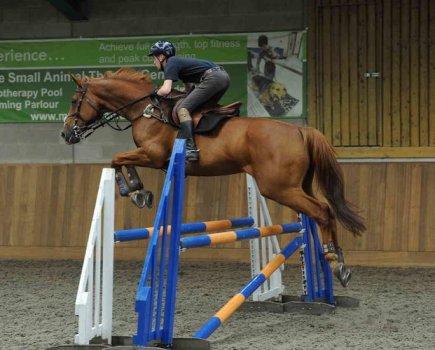How you enter at A and proceed down the centre line is crucial, because it sets the tone for the rest of your dressage test.
This is the first impression that the judge(s) will have of you and your horse, and the first mark they will give, so you’re aiming to leave a positive and lasting impression.
“Riding the centre line is one of those movements that is all too often overlooked when riders are training,” says six-times Paralympic champion Natasha Baker.
“They concentrate on circles and other movements, yet in each test there are at least two centre lines so it’s important to practise them too.”
A good centre line
When marking the centre line, the judge is looking for straightness, harmony and accuracy.
Riders should beware throwing away marks for inaccuracies, such as lacking total straightness on that all-important centre line.
The last time you ride up the centre line you will need to factor in halting and saluting at X.
How well you halt on the centre line will also influence the mark you receive.
Don’t rush into the arena
If you find that you horse tends to rush as you turn into the arena, then you’ll need to incorporate half-halts, especially as you come around the corner.”
“Practise leg yielding into the corner to keep your horse under control and ensure that they’re focusing on you,” adds Natasha.
“As soon as they go to rush, make a circle or turn. Don’t allow them to run away with you; make sure that you’re the one in control.”
When you’re riding or training at home, it’s important that you are consistent and don’t allow your horse to rush. If they try to then correct them — by learning not to do it at home, they shouldn’t do it at a competition either.
“When you’re in a competitive environment, put in a 10m circle or a transition before the bell goes and prior to riding down the centre line to get your horse back on the hind legs and listening as you half halt,” suggests Natasha.
Use the corners
How well you ride the corner before turning on to the centre line will affect the turn.
If you ride into the corner correctly, you’ll give yourself more room to make the turn.
“Making use of corners is really important to ensure that you get the accuracy right to get straight onto the centre line. Make sure that you leg yield and get deep into the corner to set you up really well,” confirms Natasha.
“It’s also important to look where you’re going as you come around the corner.
“I try to focus on the judge and that really helps me to
get around the corner and sets me up for a nice straight centre line.”
Natasha’s top tip
“When I’m at home I often practise leg yielding and spiralling in and out on a circle. I find that this really helps as then I can get my horse’s rib cage into the corner and get them soft and supple around my inside leg.
“Support the horse with the outside rein and your outside leg, set them up and get them straight for that centre line.”
Over-shooting
The centre line runs from A to C, in a straight line.
If you wait until your horse reaches A to make the turn, they will overshoot it.
In order to nail your centre line you need to turn on to it before you get there. Measure out the distance of the short side of a dressage arena at home and mark out the centre line with two cones or similar so that you have to ride through them.
You’ll soon get a feel for where you need to turn in order for your horse to trot on to the centre line accurately, rather than under or overshooting it, which will cost you precious marks.
Make an accurate turn
Accuracy is really important when it comes to centre lines.
“When commentating I see a lot of competitors failing to make the halt at the right marker or not even making it onto the centre line,” says Natasha.
“If you’re struggling to find the centre line, set out some cones or poles on the ground either side of your arena’s centre line before mounting up and practising riding between them.
“As you get more confident and comfortable riding straight down the centre line you can take away the poles or cones or reduce the number you are using.”
Visualise movements
Some riders find it helpful to visualise movements. If this is you, sit down with a pen and paper, draw a dressage arena and mark the centre line.
If you can’t find the centre line then you won’t be able to find the 10m line for 10m circles.
“Be strict on yourself,” reminds Natasha. “If you’ve fallen 1m short of the centre line then circle around and do it again.
“Keep repeating the exercise until you’re bang on the centre line every time. Having a pair of eyes on the ground if you don’t have arena mirrors is also really helpful.”
Staying straight
To get straightness you need suppleness, explains Natasha, which means it’s important to work on suppleness, as this will lead to improved straightness in your horse.
These are two elements of the Scales of Training.
“Work on things like a gentle leg yield or shoulder-in to get your horse working over and through their body,” she says.
“Gradually build up to doing a full centre line. If your horse goes down the centre line and starts to wobble, then push them in the opposite direction to where they’re going.
“Combine the centre line with a few steps of leg yield and then ask for that straightness again. It’s important to get that alignment through their body and the reins to feel that straightness.”
Aim for the higher marks
If you find yourself regularly scoring fives and sixes (or lower) for your centre line, you need to figure out why in order to improve your dressage score.
Have a look at the judge’s remarks on your test sheet or get some help from expert eyes on the ground.
- Is it an accuracy problem?
- Is it because your halts aren’t square/straight?
- How is your move off out of the halt?
“There are a lot of components to the centre line and so it’s about pinpointing what is pulling that mark down from a seven or an eight and focusing on that,” says Natasha.
“Practise the exercises I have mentioned in the situations above and, if necessary, ask a trainer or a knowledgeable friend for advice.”








